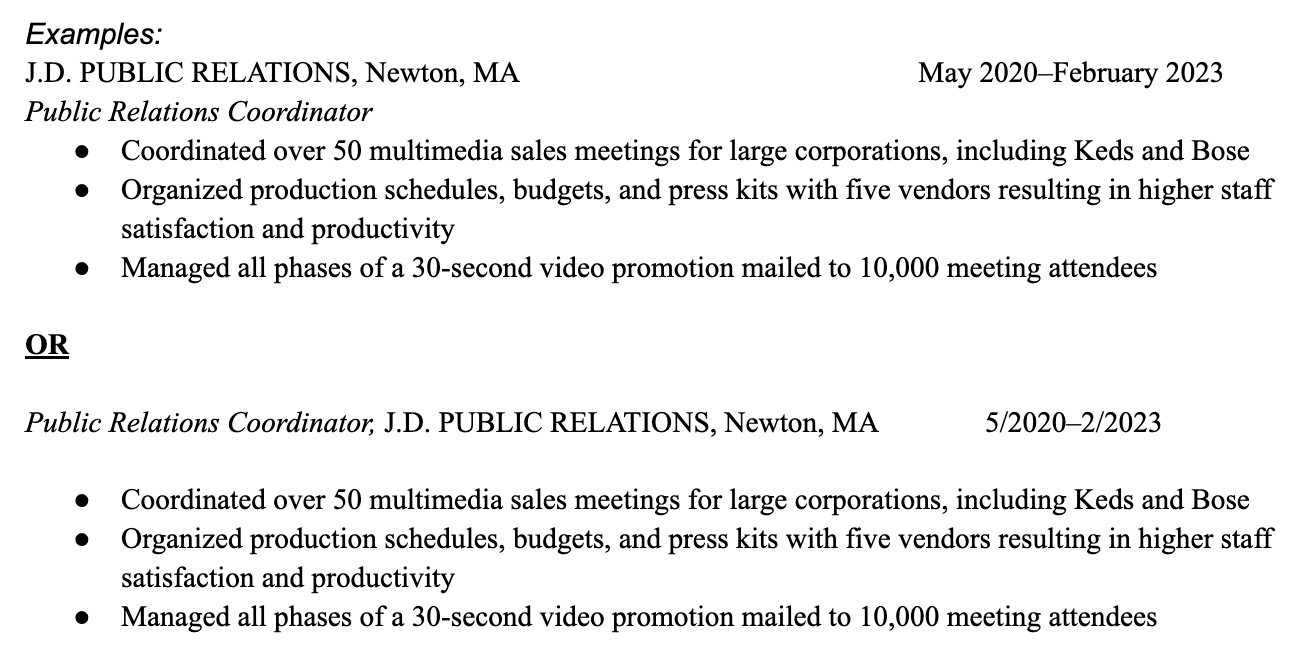Style and Format Tips
- Limit the length to one full page, unless you are a career changer or have extensive experience. Regardless of your experience, a resume should not be more than two pages.
- For each role, put the most relevant and tangible information at the top. While you’re a student, move the Education section to the top. After graduation, move it to the bottom.
- Use reverse chronological information (most recent is first).
- Use bolded, italicized, and CAPITALIZED formatting to create a hierarchy of information (for instance, bold all job titles).
- Proofread! Be consistent in format (font, font size) and content! These are very common mistakes you can easily avoid. Pro tip 1: Read it out loud to yourself. Pro tip 2: Ask another person to proofread for you.
- Use a basic, readable font like Verdana, Georgia, or Times New Roman, size 10–12 point.
- One inch or .5 inch margins are recommended. Don’t make margins less than .5 inches.
- Use short sentences in bullet points to make information easy to read.
- Keep information formal; avoid personal pronouns (like “I” or “We”).
- Make it visually appealing, but clear and easy to read above all else.
- Use PDF when sending resumes via email if you need to preserve formatting.
- When adding numbers, any number over 10 should be in the numerical format, any number under 10 should be written out with letters, i.e., seven.
- Avoid lonely words—one or two words that roll over to the next paragraph line.
Language Tips
- Be specific rather than general.
- Start each bullet with a verb. View a list of example verbs.
- Add facts (quantify or qualify—use numbers and dollars when appropriate).
- Focus on the skill, rather than task-based—i.e., not “answer phones” (task) but “provide customer information over telephone” (skill).
- Identify your value add—make sure each word counts and relates back to why you are suited for the job you are applying for.
Sections of a Resume
Contact Information
- Include your name, cell phone number, location, email address, and LinkedIn link
- What do you do if people have a hard time pronouncing your name?
- You can add a quick guide to pronouncing your name, for example, Tuh-MAR.
- What do you do if people have a hard time pronouncing your name?
- You don’t need to put your full address; your current city and state is good. If you’re applying for jobs located in person in a different city, state, or country, you may need to answer the question “Are you willing to relocate” in an interview. Make an appointment with us to discuss your answer.
Education
For most recent graduates or those still in school, your education is the strongest experience you have in your field. If this is the case, this information should go first. Include type of degree, concentration, academic honors, and date of graduation or expected graduation.

For formatting examples, explore our sample resumes.
Experience
List pertinent experiences (for the job you are applying for). This includes paid work, summer jobs, internships, volunteer work, school activities, and organizations. Include the name of the organization, city, and state, dates employed, your job title, and a brief job description.

Some people switch the employer and the job title; that’s ok! When you receive a promotion, we recommend having the employer at the top.
For formatting examples, explore our sample resumes.
Skills
Include particular skills that are relevant to the position. You can list them separately (as done below) or all in one group. You can preface skills with level of competency (such as “proficient in...”). The skills you include should focus on technical, software program, languages, etc. The “soft skills” should be embedded, and clear, within your experience.
Example:
Editing: Avid, Dreamweaver, Adobe Photoshop, iMovie
Equipment: Avid Media Composer, Toaster 100, Steenbeck, Super 8mm, 16mm camera
Computer: Excel, Word, PowerPoint, SPSS, Macintosh and/or PC platforms
Languages: Fluent in English and Spanish, conversational French
Other Sections You Can Include
AFFILIATIONS: clubs you are a part of, professional memberships
AWARDS/CERTIFICATIONS: accomplishments that show you have taken additional steps to make yourself knowledgeable of your field
For guidance and more personalized questions, contact your career advisor.